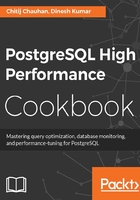
Chapter 1. Database Benchmarking
In this chapter, we will cover the following recipes:
- CPU benchmarking
- Memory benchmarking
- Disk benchmarking
- Performing a seek rate test
- Working with the fysnc commit rate
- Checking IOPS
- Storage sizing
- Discussing RAID levels
- Configuring pgbench
- Running read/write pgbench tests
Introduction
PostgreSQL is renowned in the database management system world. With every PostgreSQL release, it's gaining in popularity due to its advanced features and performance. This cookbook is especially designed to give more information about most of the major features in PostgreSQL, and also how to achieve good performance with the help of proper hardware/software benchmarking tools. This cookbook is also designed to discuss, all the high availability options we can achieve with PostgreSQL, and also give some details about how to migrate your database from other commercial databases.
To benchmark the database server, we need to benchmark several hardware/software components. In this chapter, we will discuss major tools that are especially designed to benchmark a certain component.
I would like to say thanks to the Phoronix Test Suite team, for allowing me to discuss their benchmarking tool. Phoronix is an open source benchmarking framework, which, by default, provides test cases for several hardware/software components, thanks to its extensible architecture, where we can write our own test suite with the set of benchmarking test cases. Phoronix also supports to upload your benchmarking results to http://openbenchmarking.org/, which is a public/private benchmark results repository, where we can compare our your benchmarking results with others.
Note
Go to the following URL for installation instructions for Phoronix Test Suite: http://www.phoronix-test-suite.com/?k=downloads.